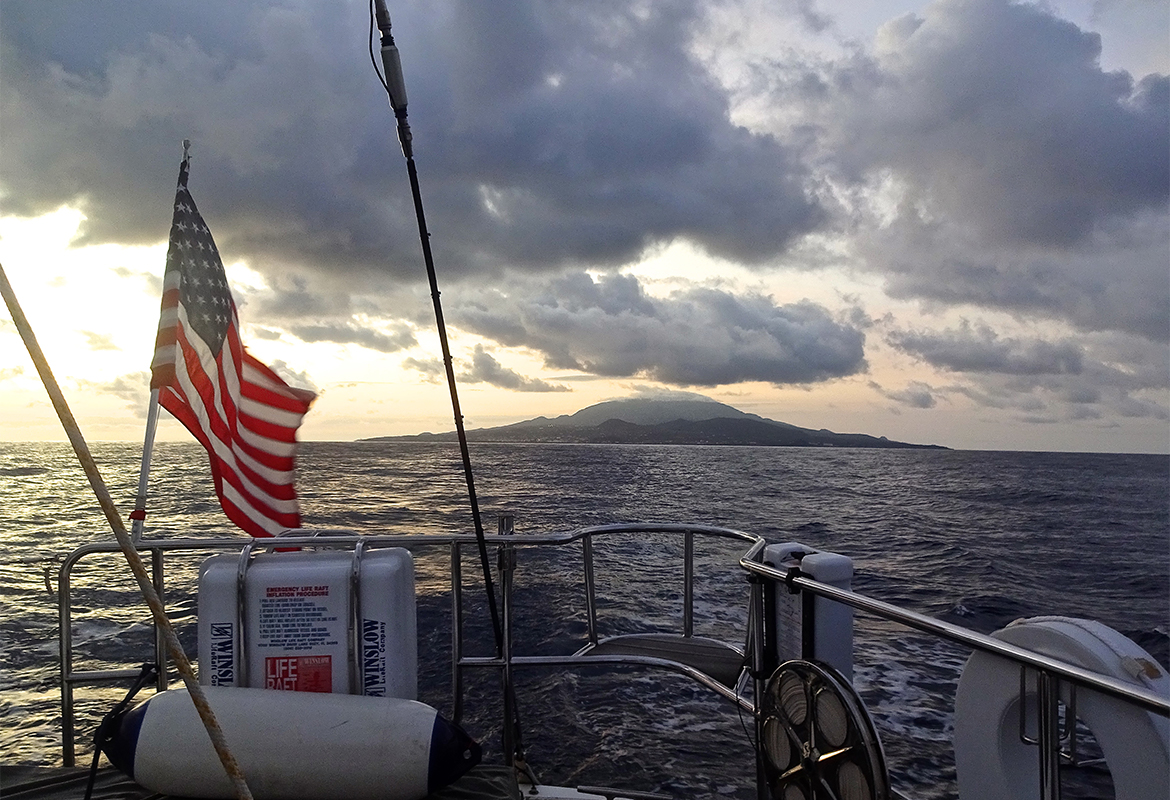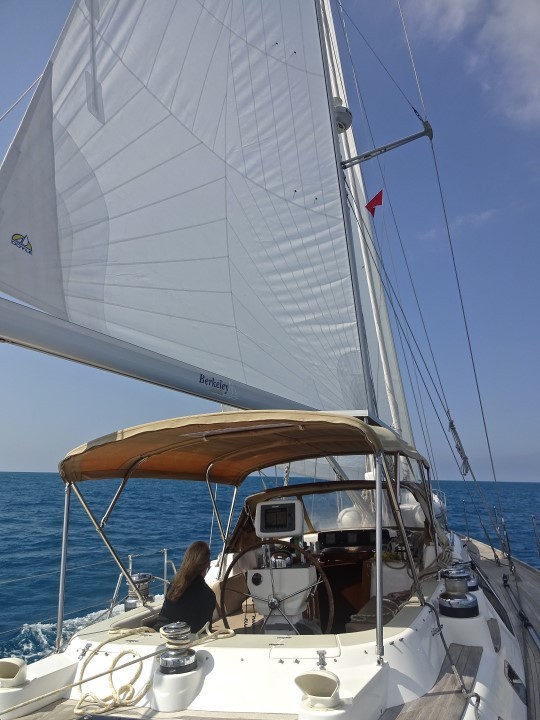The Nature Island
Dominca, Leeward Islands It is said that if Christopher Columbus came back to the Caribbean, the only island he...

After a stormy night in Pantelleria, we pulled the dock lines just as the sky began to brighten, and inched Berkeley East, as quietly as possible, out of the small harbor. While we had dodged any controversy concerning BE’s VAT (Value Added Tax) clock with the local authorities, we didn’t want to give anyone an opportunity to change their minds. It was finally the last leg to Tunisia to get Berkeley East out of the European Union and give her another 18 months in the EU.
In preparation for entry into Tunisia, we inventoried alcohol, electronics and cash, and stashed the drones in sail bags, as far out of sight as possible; drones are illegal in Tunisia. We had heard horror stories about entering the African country, with searches of everything, right down to spare nuts and bolts. In other instances, a little baksheesh (bribe) was paid and all was good. We wanted to be prepared for anything.
We chose the port of Gammarth for its proximity to Pantelleria, just a long day sail. It is an unfinished marina, so there were no facilities, and it was far from anything one might want to see in Tunisia, but we planned to get in and get out of Africa as quickly as possible. We had just five days left of our Tunisia insurance rider, no time to risk getting trapped by weather.

The trip was uneventful. On arrival in Gammarth, we were directed to the fuel dock and greeted enthusiastically in English. The immigration officer spoke excellent English, so we were able to understand very clearly that he wanted a gift to help us have a “special” entry, including the original stamped document of our entry into, and exit from, Tunisia, “something not everyone receives,” he said.
We were prepared to pay bribes if necessary, just a few Euros to make things go more smoothly, it is part of their culture. In contrast, we have cleared into Montenegro several times; it cost about 100 Euros for a boat Berkeley East’s size and took about 30 minutes, with no inspection and no bribes. In Tunisia, the process costs nothing officially, takes hours entering and exiting, inspections are at the whim of the officials on duty, as are requests for gifts.
After giving the immigration officer 20 Euros for the “special” entry, he asked for something for the customs officer so we could have a “quick” inspection. He then asked if we had a drone. We wondered if he had Googled Berkeley East and seen the pictures. We ignored the drone question, made a “we don’t understand” face, said that we had food and wine, and handed over another 20. The inspection was very quick, just cursory glances in a few cabinets, everyone was happy.

The next morning, when we went to check out of the country, our English-speaking friend with the “special” entry process was nowhere to be found. In his place was a very formal, serious officer who spoke no English at all. We didn’t receive the original stamped document as promised, only a copy after we pantomimed it was needed. Before we were allowed to leave, there was another inspection of Berkeley East, by the same customs guy who received 20 Euros for the “quick” search; we wondered what they could possibly think we had acquired since arriving the day before. This time, he opened nearly every drawer, cabinet, appliance, purse, bag, but somehow managed to miss the liquor cabinet. It was hot, so we offered them some aqua, their response being “vodka?” Given the language barrier, they had no idea how to communicate their request for a gift, but it was clear they wanted liquor. Mid search the word “vodka” was repeated, unfortunately we didn’t have any, so we offered tequila, or wine; they made a face and left. And so did we, setting a course directly back to Italy. After several weeks of planning and much effort to get there, less than 24 hours of arriving in Tunisia, we were happily headed out of Africa.
It would take us about four hours to be officially out of African waters. Within just a few minutes of our departure, we discovered that we had actually left Tunisia with something that was not on BE when we arrived, a boatload of flies. While we would have liked to return them, we carried on, killing at least a hundred in the next hour.

While getting from the island of Pantilleria to Tunisia was a day sail, moving to our next destination of Sardinia would take about 24 hours, at least at BE’s typical speed. The journey began with some beautiful sailing, the seas were a rolly and the sky was menacing, but Berkeley East was flying at 9 knots, and at that pace, we would arrive too early. We prefer to not land at an unfamiliar port in darkness, but we knew conditions were likely to change so we took the wind, and speed, while we could.

Night passages are not the leisurely evening cocktail sail around the harbor, as one might think. Thousands of miles offshore, 24-hour watch schedules, traffic schemes to cross, the possibility of floating containers toppled off ships, sleeping whales just under the surface, unlit boats, military vessels rousting sailboats in the night, rain, lightning; all things possible, all adding a level of concern and complexity to moving BE in the dark.

Luckily we had a nearly full moon to illuminate the lightning that was striking all around Berkeley East. We were surrounded by electrical activity, but it was as if we were in a protective cocoon that was keeping the storms at bay.


Anxious for the sun to rise, we were happy to see the clock strike six. But our enthusiasm was dampened with thick cloud cover and 27-knot winds as we were weaving through rocks to our Sardinia anchorage.

Still, we were out of Africa, and back in Italy, mission accomplish. We planned to sleep for a day, and spend the next few days on land exploring the south of Sardinia. Then we looked at the weather forecast, which told us to keep moving through the wind and waves to get in position for another overnight passage to Spain; Sardinia would have to wait.
We skirted along the coast in 25-knot winds and six-foot waves, both of which were predicted to be behind us, making for a comfortable sail on BE. But most of the time, the swells were rolling Berkeley East gunnel-to-gunnel. While neither of us gets seasick, these types of conditions are unsettling. We have learned to keep BE stocked with an assortment of Pringles suitable for every situation. We never eat the crisps on land, but the light salty flavor keeps any queasiness at sea under control.


After three days of moving, Berkeley East was anchored in Isola di San Pietro, an island about five miles off the west coast of Sardinia, 190 miles from Menorca, Spain. We would make the passage as soon as the seas subsided.
